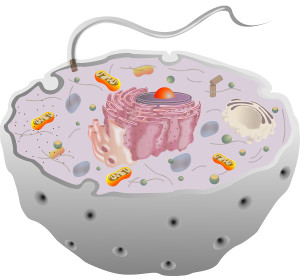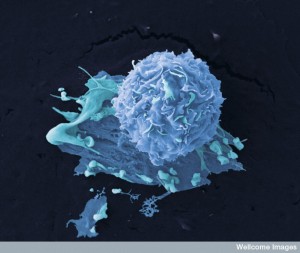It is surprising that cells have so many elaborate ways to communicate with each other. Cytokines and neurotransmitters are well known methods. Recently, very unusual new signaling techniques have been discovered, such as small nano tubes (cytonemes) in which cells send many types of signals including important genetic information and even viruses.
Increasingly, the ubiquitous use of vesicles has been shown to be extremely important for all types of cellular communication. A previous post described the universal use of vesicles among all types of cells—bacteria, plants, and animals. One important type of vesicle derived from cellular membrane is called an exosome.
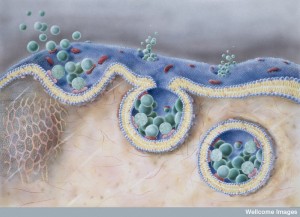 Now, it has been found that there is a vast flow of genetic information between cells and organelles using exosomes. Each type of bodily tissue uses exosomes in different complex ways. They are critical for stem cells to make new types of cells and in signaling for cell death.
Now, it has been found that there is a vast flow of genetic information between cells and organelles using exosomes. Each type of bodily tissue uses exosomes in different complex ways. They are critical for stem cells to make new types of cells and in signaling for cell death.
Of all cells, cancer cells use exosomes the most. They send genetic codes to build machinery in exosomes either short or long distances with the purpose of altering environments to make them more hospitable for cancer. The effects of these exosome signals help cancers grow, help them travel to new places and help them metastasize. Many kinds of RNA messages are sent in cancer exosomes—messenger RNA, microRNAs and other short and long non-coding RNAs. Just as microbes send information about antibiotic resistance, cancer exosomes include information to help cancer cells resist new treatments.
This post will first briefly outline general information about signaling that is covered in other posts in more detail. Then, it will discuss vesicles, exosomes and how intelligent cancer cells communicate with exosomes.
Wireless Signaling
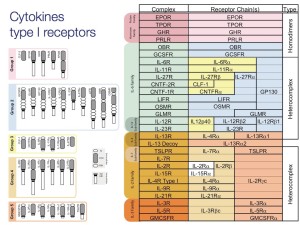 Wireless receivers (radio, TV and cellular phones) and electromagnetic signals (text, phone, wi-fi) allow humans to communicate in many ways. Receivers include eyes, ears and touch sensory neurons; signals include light, sound and pressure. Both cells and humans can only pick up the signals for which they have receivers. Cells build specialized receptors for different types of signals.
Wireless receivers (radio, TV and cellular phones) and electromagnetic signals (text, phone, wi-fi) allow humans to communicate in many ways. Receivers include eyes, ears and touch sensory neurons; signals include light, sound and pressure. Both cells and humans can only pick up the signals for which they have receivers. Cells build specialized receptors for different types of signals.
All cells use wireless signals. Human cells use thousands of different types of signals—cytokines, chemokines, neurotransmitters, gliatransmitters, peptides, protein factors, photons, mRNA, miRNA, lncRNA and many types of electricity (electrical synapses, calcium waves, axon spikes, protein gradients, electric fields, synchronous oscillations). Communication between cells occurs at many different levels at the same time.
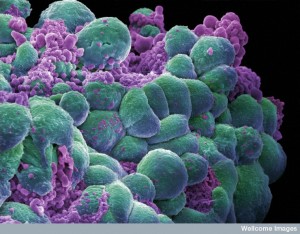 While all cells (immune, glia, epithelium, platelets, etc) use many elaborate signals, perhaps the most complex signaling is from the community of cancer cells. Recently, it has become clear that a very advanced form of communication between cancer cells utilizes exosome vesicles carrying all types of important protein and genetic information to alter cellular function and to change whole environments. These messages transform other cells into helpful comrades of the cancer.
While all cells (immune, glia, epithelium, platelets, etc) use many elaborate signals, perhaps the most complex signaling is from the community of cancer cells. Recently, it has become clear that a very advanced form of communication between cancer cells utilizes exosome vesicles carrying all types of important protein and genetic information to alter cellular function and to change whole environments. These messages transform other cells into helpful comrades of the cancer.
Outline of Signaling
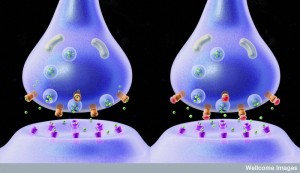 Most are aware of neurons signaling with neurotransmitters. It is not widely known that many neurons use multiple different neurotransmitters at once for different purposes and that these can change with different kinds of neuroplasticity. It is, also, not generally known that all glia cells use most of these same signaling molecules, called gliatransmitters.
Most are aware of neurons signaling with neurotransmitters. It is not widely known that many neurons use multiple different neurotransmitters at once for different purposes and that these can change with different kinds of neuroplasticity. It is, also, not generally known that all glia cells use most of these same signaling molecules, called gliatransmitters.
Cytokines and chemokines are major types of molecules used for complex signaling by immune cells. What is not widely appreciated is that neurons use these cytokines as well, and immune cells use neurotransmitters and gliatransmitters, as well. Complex synapses related to pain and inflammation can involve ten different cells at once—neurons, glia, many kinds of immune cells—using all of these molecular signals and receivers. Very complex communication occurs in intestinal and skin epithelial cells who control chatter between trillions of friendly and unfriendly microbes and immune cells. T cell signaling is extremely complex; T cells signal from the CSF to the brain triggering either normal cognition or when infected, the “sick feeling”.
 Electrical communication is extremely complex and used by virtually all types of cells in different ways. Most know about the neuron action potential along the axon. Less are are aware of electrical synapses used by many neurons and glia. In fact, molecular and electrical communication are closely related since electrical synapses lay the architectural plan that the chemical synapses are built on. But, at the same time, cells use calcium signaling, electrical fields, potentials and synchronous brain oscillations as major forms of signaling. Very recently photons have been found to be used as well.
Electrical communication is extremely complex and used by virtually all types of cells in different ways. Most know about the neuron action potential along the axon. Less are are aware of electrical synapses used by many neurons and glia. In fact, molecular and electrical communication are closely related since electrical synapses lay the architectural plan that the chemical synapses are built on. But, at the same time, cells use calcium signaling, electrical fields, potentials and synchronous brain oscillations as major forms of signaling. Very recently photons have been found to be used as well.
Many of these same cells communicate by touch. Immune cells touch and present information to each other. Glia cells touch the neurons and blood vessels regulating synapses and blood flow.
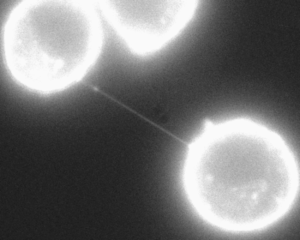
A recent discovery demonstrated that almost all cells use small nanotubes (called cytonemes) to send and receive molecular information and viruses. These have not been discovered previously because they are too small to be easily seen. But, they are now known to be very common extending a distance of up to a hundred cells. They are a major way that viruses spread.
A previous post has discussed vesicles as another universal type of communication mechanism. There are small and large types of vesicles including the critical lysosomes that break down cellular debris and invading microbes. Many different types of vesicles are used for transport of material throughout the body. Microbes use then to position gas for movement or light reactions, but, also to send toxins and make their own viruses. Neurons are noted to pick of vesicles as a transport mechanism for prions causing spread of degenerative illness.
Many organelles inside cells use elaborate signaling. Cilia in all cells are receivers of many of these signals. In fact, the primary cilium is perhaps the cell’s brain (see post.) Primary cilium have specializations for sensing hearing, sight, smell, urine flow, cartilage pressure and blood flow.
Mitochondria have elaborate communication with the cell through signals and by docking at the endoplasmic reticulum. Through this communication they regulate energy, apoptosis and calcium in the entire cell.
Plants, also, have very elaborate communication as well including transfer of genetic materials, touch, chemicals in air, roots, fungal wires, sound, magnetism. Receptors include gravity, pressure, sound, light and possibly magnetism. Microbes have a surface honeycomb pattern with thousands of receptors that have extreme sensitivity.
Ubiquitous Vesicles
The idea of a vesicle budding from a membrane is simple enough. The process is actually extremely complex and uses elaborate machinery with hundreds of motors and interlocking large proteins. Somehow, in unknown ways, these extremely elaborate mechanisms can operate in milliseconds.

In synapses, vesicles for neurotransmitter release are released and then recycled; this can occur in milliseconds. The process itself is highly intelligent, but the end result is even more so with specific signals and genetic information sent to particular cells and locations. The ends of axons at the synapse can have hundreds of waiting vesicles, each with 2000 neurotransmitters inside. Some dock at the active zones, ready to go when triggered by calcium. Three different processes have been discovered, but they are not fully understood. There are slow (ten seconds), fast (1 second) and very fast cycles (milliseconds).
Vesicles are used by all cells in thousands of different ways. Microbes in the ocean send nutrients to those that cannot use photosynthesis to make their own energy and material. All types of large molecules that can’t be sent through membranes are sent in vesicles. Those vesicles travelling between endoplasmic reticulum and Golgi have many important functions.
Inside cells, vesicles maintain completely different environments, such as the destruction factories in lysosomes. There are hundreds of specific environments maintained for different purposes. Some vesicles are hijacked by viruses, such as rabies, that travel along the axon to the nucleus.
 There are multiple different ways that vesicles are produced in several different cellular pathways. They vary in size, purpose and destination. Lysosomes are, in fact, critical to many of the most important cell functions, such as responses of mTOR to nutrients.
There are multiple different ways that vesicles are produced in several different cellular pathways. They vary in size, purpose and destination. Lysosomes are, in fact, critical to many of the most important cell functions, such as responses of mTOR to nutrients.
Transportation pathways in the body, like blood vessels, are filled with a variety of different vesicles with varied purposes and destinations. Exosomes are tagged with specific proteins that designate where they come from and where they are to be sent. A specific complex regulates this transport system. It is called ESCRT or endosomal sorting complex required for transport. The sorting complex helps regulate what types of cargoes are carried, such as proteins, messenger RNA and microRNAs.
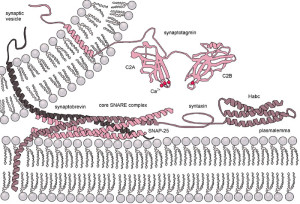 Vesicles use a surprisingly complex process with scaffold molecules assembling at the lipid membrane. They pinch the lipid double layer, which then bends, and forms a membrane bulge that grows. The proteins make a circular matrix; then, the scaffolding matrix breaks off from the circular vesicle that travels to its destination. Specific tags and receptors are imbedded in the membrane to show where it is going to be received. At the destination, the process works in reverse with the scaffold first built around the vesicle as it merges into the membrane.
Vesicles use a surprisingly complex process with scaffold molecules assembling at the lipid membrane. They pinch the lipid double layer, which then bends, and forms a membrane bulge that grows. The proteins make a circular matrix; then, the scaffolding matrix breaks off from the circular vesicle that travels to its destination. Specific tags and receptors are imbedded in the membrane to show where it is going to be received. At the destination, the process works in reverse with the scaffold first built around the vesicle as it merges into the membrane.
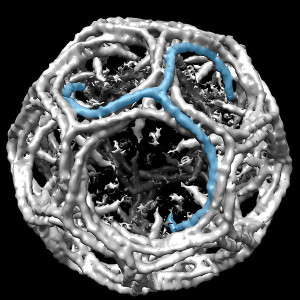
There are different kinds of scaffolds and coats. Clathrin is used most often outside of the cell and from the Golgi to the outer membrane. Thirty six different kinds of SNARE molecular complexes recognize the unique cargo and help the vesicle fuse. There are more than 60 different SNARE proteins and motors. The process, also, uses ATP energy.
Engulfment is the reverse process to vesicle budding and is, also, used by many different cells. Macrophages engulf microbes putting them in a vesicle. These sacs are, also, tagged for destruction in lysosomes, other sacs.
There are many types of vesicles including:
- Lysosomes used for waste disposal
- Transport vesicles move material from from compartment to compartment.
- Plant vacuole vesicles contain mostly water for osmotic control and storage of food.
- Secretion vesicles send signal molecules.
- Gas vesicles control gas content of a microbe for light positioning and movement.
- Extra cellular matrix vesicles contain molecules to build bone matrix.
- Exososmes
Exosomes

Exosomes are approximately 40 to 100 nm is size and sometimes have the appearance of a cup. They are lipid membrane vesicles (made of cholesterol, ceraminde and sphingolipids) but with multiple enzyme proteins on board (different proteins such as GTPases, annexins, integrins and tetraspanins). Research finds that their contents include thousands of different RNAs, at least 500 microRNAs, and hundreds of different proteins and lipids.
Exosomes can either stay right near their release site or travel throughout the body. Travel routes include almost all bodily fluids such as blood, effusions, urine, amniotic fluid. They greatly influence the target tissues.
Annexins are sent in vesicles to alter cellular scaffolding functions. They often have immune molecules and special adhesion molecules on their surface that accurately target the material to be picked up. Exosomes have special factors that affect the types of cells that stem cells make and can affect important metabolic functions. These can cause cells to suddenly die or the opposite—wildly making more cells.
Cancer Signals Serve Many Purposes
 Cancers are very complex tissues with many different kinds of cells that work together through a variety of signaling. Almost all cells secrete proteins, but with cancers the normal communication pathways are altered. Exosomes are critical in this process because of all the ways they can alter metabolism and the function of cells.
Cancers are very complex tissues with many different kinds of cells that work together through a variety of signaling. Almost all cells secrete proteins, but with cancers the normal communication pathways are altered. Exosomes are critical in this process because of all the ways they can alter metabolism and the function of cells.
Communication between cancer cells is unique. Not only are they operating as a community with shared offensive and defensive behavior, but they use all of the ordinary forms of cellular communication, as well as new ones. They use these signals with unusual savvy to benefit the entire group. Cancer cells are able to alter their metabolism, just like advanced T and B-lymphocytes and some bacteria. Cancer cells use metabolic cycles as signaling devices, including the Krebs cycle. These signals thwart attempts by the normal administrative cellular signaling to stop excessive replication.
Surprisingly, cancer cells fool most other cells, which often cooperate with them through back and forth signaling to alter structures (communication with fibroblasts) and blood vessels (with endothelial cells) to build the new powerful cancerous organ. They trick immune cells into giving them growth factors as if they are healing a wound, including making blood vessels leaky. They chatter as a community, like microbes, and make elaborate defenses against any attack from immune cells, bacteria and viruses.
Cancers Use Exosomes More Than Other Cells
Cancers use more exosomes than other cells. In cancers, exosomes carry signals involved with apoptosis, cell differentiation, building blood vessels and metastasis. They send genetic machinery that gives comrade cells more ability to multiply. This communication can determine the outcome of the cancer. Recent studies show that if large amounts of exosomes are found, it is a bad clinical sign. Glioblastoma has been found to use multiple specific messenger RNA signals in exosomes to many different cells. They cause more growth of the tumor and more cell division.
Many critical factors regulate whether a cell lives or engages in pre-programed suicide. These critical life and death factors are sent in exosomes, such as kinase enzymes, Bcl-2 and caspase proteins. Exosomes with this material can give a signal to kill another cell or to kill itself. Exosomes can protect cancer cells from cell death, but kill other cells. They send signals to dramatically increase the production of certain cancer cells.
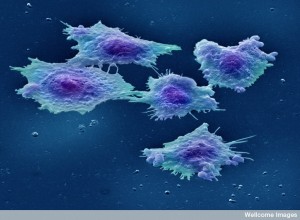 Cancer cells usually start developing in one particular sub region, or niche, that is hospitable to specific proteins and metabolic pathways. After a while, cells increase their exosome communication and hijack elaborate systems that make other vesicles for secretion of a variety of molecules. Signaling begins with blood vessel cells. Cancers are particularly interested in cells that make vessels that line the outside normal protective barriers and the immune cells that are traveling in the blood. These signals are able to disrupt the normal function. They, also, increase the size of the unique niche that the cancer has developed for its own development.
Cancer cells usually start developing in one particular sub region, or niche, that is hospitable to specific proteins and metabolic pathways. After a while, cells increase their exosome communication and hijack elaborate systems that make other vesicles for secretion of a variety of molecules. Signaling begins with blood vessel cells. Cancers are particularly interested in cells that make vessels that line the outside normal protective barriers and the immune cells that are traveling in the blood. These signals are able to disrupt the normal function. They, also, increase the size of the unique niche that the cancer has developed for its own development.
Cancers Use Exosomes for Critical Genetic Information
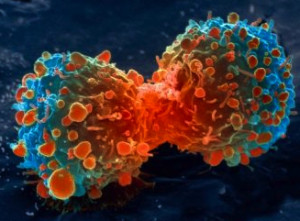 What is so striking about exosomes is that they can send genetic information to build particular machinery. Microbes send specific machinery to help comrades fight off antibiotics (antibiotic resistance genes.) Cancer cells send the exact genetic molecular machinery by sending cytokines, many kinds of RNAs, proteins, and lipid signals. MicroRNAs can bind and alter specific parts of the messenger RNA by stopping it, altering it or cutting it into other pieces. This changes the types of protein machinery that is made.
What is so striking about exosomes is that they can send genetic information to build particular machinery. Microbes send specific machinery to help comrades fight off antibiotics (antibiotic resistance genes.) Cancer cells send the exact genetic molecular machinery by sending cytokines, many kinds of RNAs, proteins, and lipid signals. MicroRNAs can bind and alter specific parts of the messenger RNA by stopping it, altering it or cutting it into other pieces. This changes the types of protein machinery that is made.
In the cancer niche, many more microRNAs are made than elsewhere. Cancers use them as signals in the larger amount of exosomes sent to their comrades that are building the cancer. MicroRNAs are one of the most critical factors in exosome communication. It is just being appreciated how significant they are in regulating normal genetic networks.
In particular, microRNAs inside exosomes are not destroyed by the normal protective RNAase enzyme in the blood stream. Inside the exosome membrane, RNAs are surrounded by lipid molecules to avoid the normal protection that the body has against genetic material. This allows signals to reach cancer cells that thwart apoptosis signals that would otherwise destroy the cancer cell. It allows cancers to grow. Another result is that cancers can influence the blood vessel cells to make more vessels for the cancer (angiogenesis). These microRNAs also give the cells resistance factors to both cancer medications and radiation treatments.
Exosomes Send Information Near and Far
 Only particular cells pick up the travelling exosomes—some neighbors and some very distant cells. Sometimes, distant immune cells take them in. The microRNAs can alter their entire function.
Only particular cells pick up the travelling exosomes—some neighbors and some very distant cells. Sometimes, distant immune cells take them in. The microRNAs can alter their entire function.
Just as microbes have developed techniques to avoid the complex immune responses to their presence, cancers also hide from the many different immune cells through exosomes. Evasion of immune response by cancer cells occurs through exosomes sent by the cancer cells and those secreted by immune cells themselves. Exosomes carry material that suppresses immune responses by a pathway that stops T-reg cells. One of the critical suppressing microRNAs is miR-155 that is now a focus of intense research to find treatments for cancer.
Some of the cargoes are proteins that stop cell suicide stimulated by the immune response to the presence of the cancer. When the cancer is stressed by reactions from the immune system, the exosome material stimulates special cellular oncogenes that help avoid the signals that are calling for cell suicide (apoptosis).
 Cancers develop specific responses to cancer treatments and send them in exososmes (like microbes sending antibiotic resistance genes). If we thought bacteria are intelligent in their battles with other microbes and human cells (see post), these large complex cancer cells are far more intelligent. There are now many examples of specific anti treatment proteins that are put on the surface of exosomes—recently, melanoma and colorectal cancer. Breast cancers (HER-2 positive) secrete exosomes that are altered by growth factors and are used by the cancer to evade the effect of the medication trastuzumab. They have created resistance to this treatment by grabbing the medication and having it bind to the exososome and not the target cell. There are many other examples where cancers use exosomes to fight treatments.
Cancers develop specific responses to cancer treatments and send them in exososmes (like microbes sending antibiotic resistance genes). If we thought bacteria are intelligent in their battles with other microbes and human cells (see post), these large complex cancer cells are far more intelligent. There are now many examples of specific anti treatment proteins that are put on the surface of exosomes—recently, melanoma and colorectal cancer. Breast cancers (HER-2 positive) secrete exosomes that are altered by growth factors and are used by the cancer to evade the effect of the medication trastuzumab. They have created resistance to this treatment by grabbing the medication and having it bind to the exososome and not the target cell. There are many other examples where cancers use exosomes to fight treatments.
Usually the microRNAs come from the tissue where the cancer resides. But, not always. Some exosomes travel distances and create a new cancer niche and environment. This includes creating inflammatory responses that promote cancers and metastasis. This is seen in chronic lymphocytic leukemia, prostate cancer, gastric cancer, breast cancer as well as others. In fact, these exosomes can totally change the character of the cells that receive them.
Exosomes don’t only help the movement of cancers, but, also, their original niche that is so critical for their development. Studies show exosome material manipulating bone marrow stem cells into starting to produce cancers. A particular microRNA (miR-105) starts to make new blood vessels for early cancers. They, also, make particular proteins that make the cells along the blood vessels leak to allow easy entry of the cancer cells.
Because of all of these findings, exosomes are increasingly used as markers for specific cancers. It is already used in ovarian, prostate, esophageal and lung cancers.
There is now extensive research to use exosomes to bring treatments to target cells. It is complicated by the various immune reactions to the exosomes themselves. Up till now, liposomes have been the vesicles used for this purpose, but exosomes in the long run appear to be more relevant to the process.
Intelligent Cancer Cells Communicate with Exosomes
It is quite remarkable that cells have such advanced back and forth communication with each other. More and more physiology is now tied to this chatter. Some cells appear more complex with more advanced communication, such as neurons and T cells. But, of all the cells, perhaps cancers are the most intelligent.
Cancer cells place specific genetic material, such as microRNAs, in exosomes to make alterations in other cells in ways that will aid the cancer community. They then tag these exosomes for their exact destination. How can anyone not think that this is extremely intelligent behavior.
Where is the mind of a cell? Is it mind in nature interacting with the machinery and molecules of the cell?

